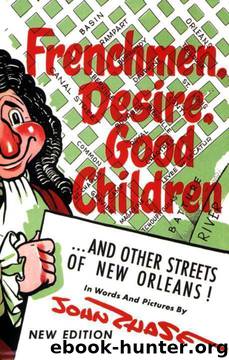Frenchmen, Desire, Good Children: . . . and Other Streets of New Orleans! by John Chase

Author:John Chase [Chase, John]
Language: eng
Format: epub
Published: 2011-08-09T01:39:00+00:00
On the river side of Camp street, Lafon's plan and the street names show more consideration for the owners of these properties: Delord Sarpy, Thomas Soulet, Robin Delogny, and Jacques Livaudais. Some of these original names remain, such as, St. Thomas for Thomas Soulet; Celeste and St. James, for Celeste Marigny and her husband Jacques (James) Livaudais; and Constance, for the wife of Robin Delogny. Although there is still a Robin Street Wharf on the river, the street named Robin was one of those changed in 1852; it is now Euterpe.
Also, there were lesser landowners, who owned parts of the main tracts: such as Richard, Gaiennie, and Poeyfarre, whose names still remain as street names. Remaining, too, is a street called Market, which led to the Market which was never built; and Orange, because it ran through the orange grove which the Jesuit fathers planted when once this region was part of their vast plantation. Annunciation street gets its name from Livaudais' part of the subdivision, Faubourg Annunciation; and Robin Delogny called his tract, Faubourg De La Course-or Race Track. A street called La Course is now Race street.
Perhaps in 18o6, when Delogny's faubourg was subdivided, there was a race track nearby. Many Creoles had race tracks on their plantations. It must be recognized, too, that when Lafon made the survey of these lands, they were even more wild and unsettled than was the Faubourg Ste. Marie as Caldwell described it when he built his American Theater. Also three important events occurred between the time of the survey and the time when the region became a settled neighborhood.
Napoleon, whose government made education a state monopoly, met his Waterloo. The territorial government of Louisiana was strongly influenced by Napoleonic France in planning its educational system. Joseph Lakanal, who had been chairman of education during the French Revolution, and who had remained prominent in French education during the Empire, came to New Orleans after Napoleon's fall. He was the last president of the College of Orleans.
The other two events were the admission of Louisiana to the Union, and the War of 1812, with the local preoccupation of the Battle of New Orleans. Following this war, the rapid growth of New Orleans was slowed; and when it resumed, the direction was different from the old Creoledominated territorial set-up. The College of Orleans closed its doors, and the Prytande and Colisde were forgotten. All that survived of the ambitious plans of Lafon and the territorial council were the classical names of the streets. These the Americans retained, because then it was the style in America to be classical.
This was the period of Greek Revival in the United States, a phenomenal new interest in Ancient Greece which prevailed during the years 1820-50. It was principally expressed in the architecture of the period-although such American cities as Athens, Georgia; Troy and Ithaca, New York; and Sparta, in eleven states, owe their names to the enthusiasm of the time. The national capitol at Washington got its Grecian
Download
This site does not store any files on its server. We only index and link to content provided by other sites. Please contact the content providers to delete copyright contents if any and email us, we'll remove relevant links or contents immediately.
| Africa | Americas |
| Arctic & Antarctica | Asia |
| Australia & Oceania | Europe |
| Middle East | Russia |
| United States | World |
| Ancient Civilizations | Military |
| Historical Study & Educational Resources |
Cat's cradle by Kurt Vonnegut(14757)
Pimp by Iceberg Slim(13777)
Underground: A Human History of the Worlds Beneath Our Feet by Will Hunt(11836)
4 3 2 1: A Novel by Paul Auster(11788)
The Radium Girls by Kate Moore(11619)
Wiseguy by Nicholas Pileggi(5315)
American History Stories, Volume III (Yesterday's Classics) by Pratt Mara L(5133)
Perfect Rhythm by Jae(5070)
The Fire Next Time by James Baldwin(5016)
Paper Towns by Green John(4789)
Pale Blue Dot by Carl Sagan(4613)
A Higher Loyalty: Truth, Lies, and Leadership by James Comey(4550)
The Mayflower and the Pilgrims' New World by Nathaniel Philbrick(4277)
The Doomsday Machine by Daniel Ellsberg(4243)
Killers of the Flower Moon: The Osage Murders and the Birth of the FBI by David Grann(4188)
The Sympathizer by Viet Thanh Nguyen(4092)
Too Much and Not the Mood by Durga Chew-Bose(4089)
The Borden Murders by Sarah Miller(4013)
Sticky Fingers by Joe Hagan(3911)
